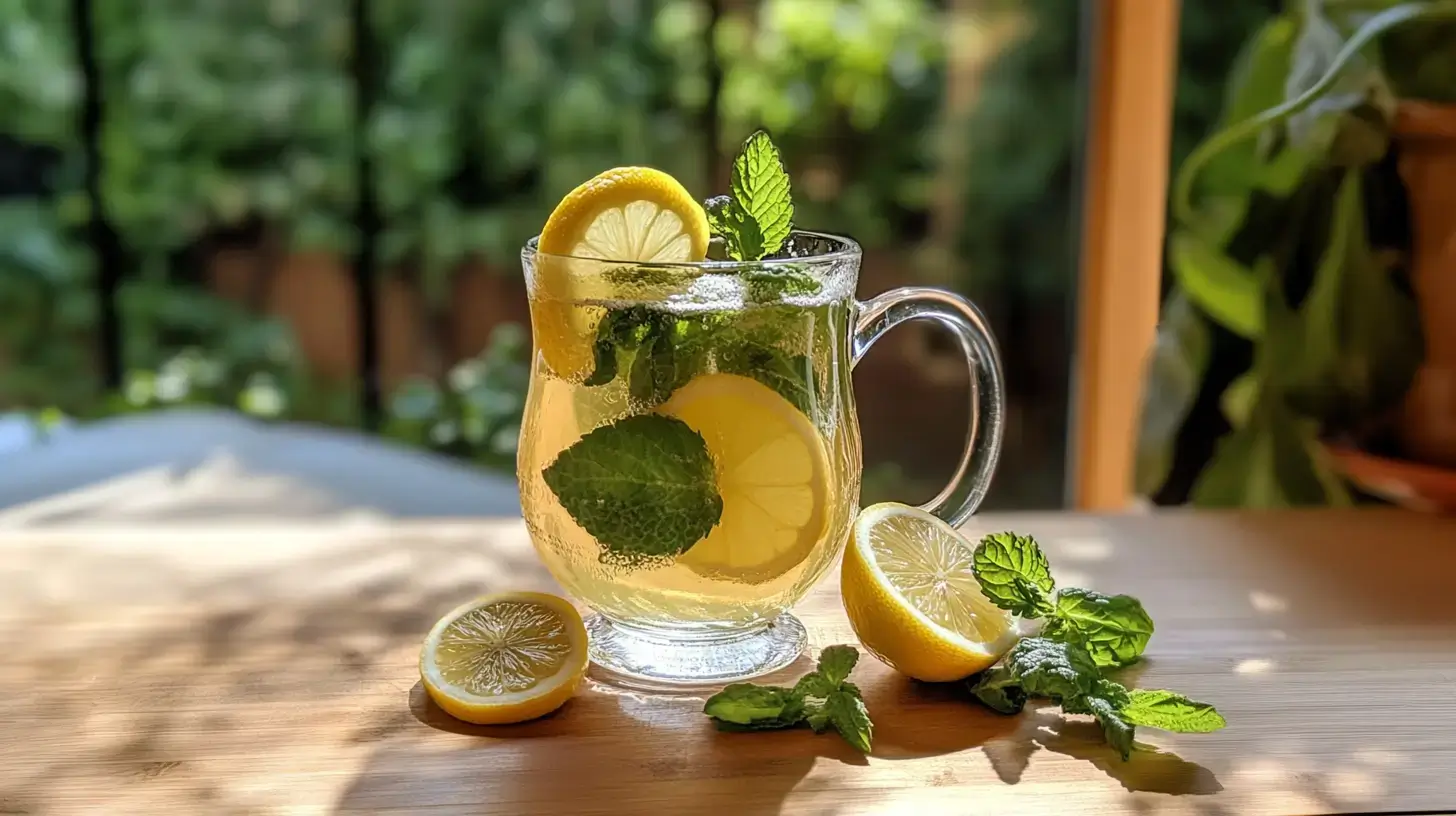Introduction: Lemon Balm Recipe
Why Lemon Balm Deserves a Place in Your Kitchen
Lemon balm recipe, with its bright citrusy aroma and subtle herbal notes, is a hidden gem in the world of herbs. Whether you’re looking to elevate your morning tea or create a fresh, vibrant pesto, lemon balm recipe offers versatility and a refreshing flavor that’s hard to beat. Beyond its culinary uses, this fragrant herb is celebrated for its calming properties and its ability to soothe digestion, making it a must-have for both your pantry and wellness routine.
What You’ll Learn in This Recipe
In this article, we’ll guide you through a simple yet flavorful recipe featuring lemon balm recipe. Whether you’re crafting a soothing Lemon Balm Tea or a tangy Lemon Balm Pesto, you’ll find step-by-step instructions to create something truly delightful. Along the way, we’ll share tips for customizing your recipe and maximizing the herb’s natural flavors. Let’s dive into the world of lemon balm recipe and get cooking!
Essential Ingredients for a Delicious Lemon Balm Recipe
What Makes Lemon Balm Recipe Special?
Lemon balm recipe is a member of the mint family, but it stands out with its unique citrusy aroma and mildly tangy flavor. This versatile herb has been used for centuries in both cooking and herbal medicine. Its refreshing flavor works equally well in sweet and savory dishes, while its calming properties make it a popular choice for teas and tinctures. Rich in antioxidants, lemon balm recipe may also support digestion, reduce stress, and even improve your mood. If you’ve been searching for an ingredient that combines flavor and wellness, lemon balm recipe is the perfect pick.
Key Ingredients for the Recipe
To get started with your lemon balm recipe, you’ll need a handful of simple and fresh ingredients. Below are the two recipe options and their corresponding ingredient lists:
1. Lemon Balm Tea
- 1 cup of fresh lemon balm leaves (washed and dried)
- 2 cups of boiling water
- 1–2 teaspoons of honey (optional, for sweetness)
- A slice of lemon or a sprig of mint for garnish
2. Lemon Balm Pesto
- 2 cups of fresh lemon balm leaves (stems removed)
- 1/3 cup of olive oil
- 2 cloves of garlic (peeled)
- 1/3 cup of pine nuts (or walnuts as an alternative)
- 1/3 cup of grated Parmesan cheese (optional, for a creamy texture)
- A pinch of salt and pepper to taste
These ingredients are simple to source and allow lemon balm’s natural flavors to shine. For the best results, opt for freshly harvested lemon balm, as it retains the maximum aroma and flavor.
Ingredient Variations or Substitutions
One of the best parts about cooking with lemon balm recipe is how adaptable it is to your preferences or dietary needs. Here are some ideas for substitutions:
- Lemon Balm Tea: Replace honey with agave syrup or stevia for a sugar-free option. Add fresh ginger or chamomile to create a more complex flavor profile.
- Lemon Balm Pesto: Swap pine nuts for almonds, cashews, or sunflower seeds for a nut-free option. For a vegan version, use nutritional yeast in place of Parmesan cheese.
These flexible ingredient choices ensure you can enjoy the recipe no matter your dietary restrictions or taste preferences.
Step-by-Step Instructions for Making the Perfect Lemon Balm Recipe
Now that we’ve covered the ingredients, let’s dive into the fun part—bringing these recipes to life. Below, you’ll find detailed, step-by-step instructions for both Lemon Balm Tea and Lemon Balm Pesto. Each method is simple to follow and results in a delicious treat showcasing the unique flavor of lemon balm recipe.
1. How to Make Lemon Balm Tea
This soothing tea is perfect for unwinding after a long day or simply enjoying a refreshing herbal drink.
Step 1: Wash the Lemon Balm Leaves
- Rinse 1 cup of fresh lemon balm leaves under cold water to remove any dirt or debris.
- Pat the leaves dry using a clean kitchen towel or paper towel.
Step 2: Prepare Your Teapot or Mug
- Place the clean lemon balm leaves into a teapot or directly into your mug. For stronger tea, you can gently crush the leaves with your fingers to release more of their natural oils.
Step 3: Add Boiling Water
- Heat 2 cups of water to a gentle boil and pour it over the lemon balm leaves. Cover the teapot or mug to trap the steam, allowing the leaves to steep.
Step 4: Steep and Strain
- Let the tea steep for 5–10 minutes, depending on how strong you like it. For a lighter flavor, 5 minutes will suffice, while 10 minutes will give you a bolder taste.
- Strain the tea using a fine mesh strainer if the leaves were loose.
Step 5: Add Sweetener or Garnish (Optional)
- Stir in 1–2 teaspoons of honey for a touch of sweetness, or garnish with a slice of lemon or a sprig of mint. Your calming Lemon Balm Tea is ready to enjoy!
2. How to Make Lemon Balm Pesto
This vibrant pesto is ideal for tossing with pasta, spreading on bread, or drizzling over roasted veggies.
Step 1: Prep the Lemon Balm Leaves
- Wash and dry 2 cups of fresh lemon balm leaves, removing any stems. This ensures a smooth texture in your pesto.
Step 2: Toast the Pine Nuts (Optional)
- For a nuttier flavor, lightly toast 1/3 cup of pine nuts in a dry skillet over medium heat for 2–3 minutes, stirring frequently to prevent burning. Let them cool.
Step 3: Blend the Ingredients
- In a food processor, combine the lemon balm leaves, 2 cloves of garlic, toasted pine nuts, and a pinch of salt and pepper.
- Pulse a few times to chop the ingredients roughly.
Step 4: Add the Olive Oil
- With the food processor running, slowly drizzle in 1/3 cup of olive oil. Stop occasionally to scrape down the sides to ensure everything blends evenly.
Step 5: Incorporate Parmesan Cheese (Optional)
- If using, add 1/3 cup of grated Parmesan cheese to the mixture. Pulse a few more times until the pesto reaches your desired consistency.
Step 6: Adjust the Seasoning
- Taste the pesto and adjust the salt, pepper, or garlic as needed. If it feels too thick, you can add a little more olive oil or a splash of lemon juice.
Step 7: Serve and Enjoy
- Use the pesto immediately or store it in an airtight container in the fridge for up to a week. For longer storage, freeze it in ice cube trays for easy portioning.
3. Expert Cooking Tips
To elevate your lemon balm recipe creations, consider these tips:
- Lemon Balm Tea: Add a splash of freshly squeezed orange juice for a unique citrus twist or serve the tea over ice for a refreshing summer drink.
- Lemon Balm Pesto: For a zesty flavor, mix in some lemon zest or juice. You can also blend in a few basil leaves for a more traditional pesto flavor.

Creative Ways to Customize Your Lemon Balm Recipe
Once you’ve mastered the basics of using lemon balm recipe in tea or pesto, the fun truly begins. This versatile herb is perfect for experimentation, allowing you to get creative in the kitchen and craft unique variations tailored to your preferences. Below are some inspiring ideas to customize your lemon balm recipe and make it your own.
1. Flavor Pairing Ideas
Lemon balm’s mild citrusy and herbal flavor pairs beautifully with a variety of ingredients. Here are some popular combinations to enhance your recipe:
- For Tea:
- Add fresh ginger slices for a warming, spicy kick.
- Blend lemon balm with mint leaves for an extra cooling effect, ideal for iced tea.
- Infuse the tea with citrus zest (lemon, lime, or orange) to amplify the citrus profile.
- Sweeten with lavender honey for a fragrant twist.
- For Pesto:
- Combine lemon balm with basil leaves for a fusion of herbal flavors.
- Add lemon zest or juice for a brighter, tangier pesto.
- Toss in a handful of spinach or arugula to increase the volume and add more greens.
- Use sunflower seeds instead of nuts for an allergy-friendly version.
Experimenting with these flavor pairings can elevate your recipe while making it feel fresh and exciting every time.
2. Versatile Recipe Uses
Lemon balm recipes are more than just a one-time treat—they’re incredibly versatile and can serve as a base for other dishes and drinks. Here are some creative ideas to repurpose or enhance your creations:
- Lemon Balm Tea:
- Use the tea as a base for iced tea or mix it with sparkling water for a fizzy herbal drink.
- Sweeten the tea and turn it into a refreshing lemon balm popsicle for hot summer days.
- Add a shot of chilled lemon balm tea to cocktails like gin and tonic or mojitos for a fresh twist.
- Lemon Balm Pesto:
- Toss the pesto with freshly cooked pasta or drizzle it over roasted veggies.
- Use it as a spread on sandwiches, wraps, or flatbreads for a flavorful lunch option.
- Swirl it into soups like minestrone or vegetable soup for an herbal boost.
- Pair it with grilled meats like chicken, fish, or shrimp for an easy marinade or finishing sauce.
By thinking beyond the original recipe, you can incorporate lemon balm into an array of meals and drinks, turning it into a staple in your kitchen.
3. Seasonal Twists
Lemon balm recipe can be easily adapted to fit the changing seasons. Here are some seasonal twists to keep your dishes exciting year-round:
- Spring: Pair lemon balm with fresh herbs like parsley or chives in salads and light dressings.
- Summer: Use lemon balm pesto as a topping for grilled summer vegetables or mix it into a refreshing yogurt dip. For tea, serve it iced with crushed berries like strawberries or blueberries.
- Fall: Combine lemon balm with warm spices like cinnamon and nutmeg in your tea for a cozy, autumnal flavor. For pesto, mix in roasted pumpkin seeds or drizzle it over roasted butternut squash.
- Winter: Add lemon balm tea to hot toddies for a soothing winter drink. Blend the pesto with roasted garlic and serve it as a warm topping for baked potatoes or casseroles.
These seasonal adaptations allow you to make the most of lemon balm no matter the time of year, ensuring your recipes stay fresh and exciting.
FAQ Section
1. What can I do with my lemon balm?
Lemon balm recipe is incredibly versatile and can be used in both culinary and wellness applications. Here are some ideas:
- Culinary Uses: Use lemon balm in teas, pestos, salads, marinades, or as a garnish for desserts and drinks. It pairs beautifully with citrus, berries, and honey.
- Infusions: Add it to oils, vinegars, or syrups for an herbal twist.
- Herbal Remedies: Lemon balm is commonly used in homemade tinctures, balms, and essential oil blends for its calming and digestion-soothing properties.
- Fresh or Dried Use: Enjoy fresh leaves in recipes, or dry them to make teas or herbal sachets for a subtle lemony aroma in your home.
2. Does lemon balm help lose belly fat?
While lemon balm recipe is not a miracle herb for fat loss, it may support your weight loss journey in a few indirect ways:
- Stress Reduction: Chronic stress can lead to weight gain, especially around the belly. Lemon balm’s calming properties may help reduce stress, potentially supporting healthier weight management.
- Improved Digestion: Lemon balm recipe can soothe digestion, reducing bloating and promoting better gut health, which may help flatten the stomach’s appearance.
- Calorie-Free Beverage Option: Swapping sugary drinks with lemon balm tea can reduce overall calorie intake, aiding in weight management.
Although lemon balm recipe may support a healthier lifestyle, it’s not a standalone solution for losing belly fat. Combining it with a balanced diet and regular exercise is key.
3. What is the magical use of lemon balm?
Lemon balm has long been associated with folklore and magical traditions, often symbolizing healing and love. Some of its magical uses include:
- Promoting Calmness: It is believed to bring peace and reduce stress, making it ideal for rituals or practices centered on relaxation and emotional healing.
- Attracting Love: Lemon balm has been historically used in love spells or charms to enhance affection and strengthen bonds.
- Clearing Negative Energy: The herb’s uplifting aroma is thought to purify spaces and encourage positivity, making it a popular choice in incense or smudging practices.
- Enhancing Sleep: Placing dried lemon balm under your pillow or drinking its tea before bedtime is believed to promote restful sleep and sweet dreams.
While these uses are rooted in tradition and folklore, they align with the herb’s soothing properties in modern herbalism.
4. Can you drink lemon balm tea every day?
Yes, you can enjoy lemon balm tea daily, as it’s generally considered safe for regular consumption. Here’s what you should know:
- Calming Effects: Drinking lemon balm tea daily can help reduce stress, promote relaxation, and support better sleep.
- Digestion Benefits: It can aid digestion and soothe upset stomachs, making it an excellent addition to your routine after meals.
- Moderation is Key: While safe, it’s best to stick to 1–3 cups a day to avoid overconsumption, especially if you’re taking medications or have a specific health condition. Consult a healthcare provider if you’re unsure about including it in your diet regularly.
Incorporating lemon balm tea into your daily routine can be a calming, health-supportive ritual, but always listen to your body and adjust your intake as needed.
Conclusion
Lemon balm is a truly versatile herb, perfect for both your kitchen and wellness routine. Whether you’re crafting a soothing Lemon Balm Tea, a tangy Lemon Balm Pesto, or exploring its magical and medicinal properties, this refreshing herb deserves a place in your home. With its calming effects, delightful flavor, and simple preparation, lemon balm recipes are a joy to make and share. Give these recipes a try, customize them to your liking, and enjoy all the benefits this humble herb has to offer!
If you’re looking for more unique and refreshing recipes, check out our Pumpkin Juice Recipe, a delightful fall drink that’s easy to make and full of seasonal flavor. It’s a perfect companion to your Lemon Balm Tea on a cozy evening.

